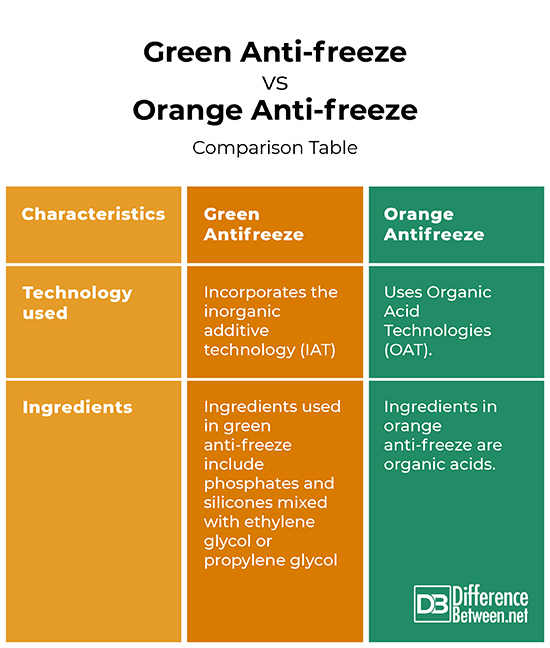No, you should not mix orange and green antifreeze. Mixing different types of antifreeze can lead to serious engine problems.
Antifreeze plays a vital role in your vehicle’s cooling system. It helps regulate engine temperature and prevents freezing in cold weather. Using the right type of antifreeze is crucial for your car’s health. Orange and green antifreeze have different chemical compositions.
They are designed for different types of engines and cooling systems. Mixing them can cause a chemical reaction. This reaction can turn the antifreeze into a gel-like substance. It can clog your radiator and reduce the coolant’s effectiveness. This can lead to overheating and expensive repairs. Understanding the importance of using the correct antifreeze can save you from potential headaches and costly fixes.
Introduction To Antifreeze
Mixing orange and green antifreeze can cause issues in your vehicle. Different antifreeze types have unique chemical properties. Combining them may lead to corrosion or engine damage.
Antifreeze is a vital fluid for your vehicle. It keeps the engine from freezing in cold weather. It also prevents overheating during hot seasons. This fluid, often called coolant, ensures your car runs smoothly. Understanding antifreeze can save you from costly repairs.Purpose Of Antifreeze
Antifreeze serves multiple purposes. It lowers the freezing point of the water in your engine. This prevents the water from turning into ice. Ice can cause serious damage to the engine. It also raises the boiling point of the water. This helps avoid overheating in high temperatures. Antifreeze contains additives. These protect the engine from rust and corrosion.Types Of Antifreeze
There are several types of antifreeze. The most common are ethylene glycol and propylene glycol. Each type has different properties. Ethylene glycol is toxic but very effective. Propylene glycol is less toxic but also less efficient. Antifreeze also comes in different colors. Green and orange are the most popular. Green antifreeze is usually made from ethylene glycol. Orange antifreeze often contains organic acids. Mixing different types can cause problems. Always check your vehicle’s manual before mixing antifreeze. “`
Credit: www.reddit.com
Orange Antifreeze Characteristics
Understanding the characteristics of orange antifreeze is crucial for vehicle maintenance. This type of coolant is distinct in its composition and usage. It is designed to offer specific benefits. Let’s explore its composition and common uses.
Composition
Orange antifreeze typically contains a mix of ethylene glycol and organic acid technology (OAT) additives. These additives help prevent corrosion and extend the coolant’s lifespan. The unique formula ensures better protection for aluminum and other engine parts.
| Component | Function |
|---|---|
| Ethylene Glycol | Provides freezing and boiling point control |
| OAT Additives | Prevents corrosion and extends coolant life |
Common Uses
Orange antifreeze is commonly used in modern vehicles. It is often found in cars with aluminum radiators. Its corrosion-resistant properties make it suitable for high-performance engines.
- Used in most GM vehicles
- Ideal for aluminum engines and radiators
- Preferred for high-mileage vehicles
Using the right antifreeze ensures engine longevity. It also helps maintain optimal performance. Always check your vehicle’s manual before selecting a coolant.
Green Antifreeze Characteristics
Green antifreeze is a crucial component in vehicle maintenance. Understanding its characteristics can help ensure your vehicle’s longevity. This section delves into the unique features of green antifreeze, emphasizing its composition and common uses.
Composition
Green antifreeze is typically made from ethylene glycol. This chemical compound is effective in preventing engine freeze during cold weather. It also helps in maintaining optimal engine temperature.
The composition includes additives that prevent corrosion and rust. These additives protect the engine and cooling system components. Another key element is the presence of dye. The green color helps in easy identification and leak detection.
Below is a table summarizing the main components:
| Component | Function |
|---|---|
| Ethylene Glycol | Prevents freezing and overheating |
| Corrosion Inhibitors | Protects engine parts from rust |
| Dye | Helps in leak detection |
Common Uses
Green antifreeze is widely used in older vehicle models. It’s suitable for cars that require frequent coolant changes. This type of antifreeze is also common in heavy-duty vehicles like trucks.
Another use is in agricultural machinery. Tractors and harvesters benefit from its corrosion protection. Many industrial engines also use green antifreeze. It ensures these engines run smoothly and avoid overheating.
Here are some common applications:
- Older model cars
- Heavy-duty trucks
- Agricultural machinery
- Industrial engines

Credit: www.youtube.com
Chemical Differences
Mixing orange and green antifreeze can be risky. They have different chemical compositions. Understanding these differences is essential to avoid damage to your vehicle’s engine.
Additive Packages
Antifreeze contains additive packages that protect the engine. These additives prevent corrosion, lubricate parts, and raise the boiling point of the coolant. Orange and green antifreeze use different additives.
- Orange antifreeze often uses organic acid technology (OAT).
- Green antifreeze typically uses inorganic additive technology (IAT).
Mixing these can neutralize the additives. This reduces their effectiveness. Your engine could suffer from poor protection.
Corrosion Inhibitors
Corrosion inhibitors are crucial. They prevent rust and scaling in the cooling system. Orange and green antifreeze have different types of inhibitors.
| Type | Inhibitor Base |
|---|---|
| Orange Antifreeze | Organic acids (OAT) |
| Green Antifreeze | Silicates and phosphates (IAT) |
Mixing these inhibitors can cause them to coagulate. This forms a sludge that blocks passages. The cooling system may fail.
Always check your vehicle’s manual. Use the recommended antifreeze type. This ensures your engine’s long-term health.
Potential Reactions
Mixing orange and green antifreeze can lead to unexpected results. Understanding these potential reactions is crucial for car maintenance. They can impact your vehicle’s performance and longevity.
Chemical Reactions
Orange and green antifreeze have different chemical bases. Orange antifreeze often contains organic acids. Green antifreeze usually has silicates and phosphates. Mixing them can cause a chemical reaction.
This reaction can produce sludge. Sludge can clog the cooling system. It may also reduce the antifreeze’s effectiveness. Over time, it can damage engine components. Avoid mixing them to keep your engine safe.
Physical Reactions
The physical properties of antifreeze matter. Mixing different types can change their physical properties. This may affect their boiling and freezing points. An altered boiling point can lead to overheating.
A changed freezing point might cause the coolant to freeze in cold weather. This can crack the engine block. Engine block damage is costly to repair. Keeping antifreeze types separate helps maintain their physical properties.

Credit: www.differencebetween.net
Mixing Consequences
Mixing orange and green antifreeze can lead to several issues. These issues can affect your vehicle’s performance and longevity. Below, we explore the main consequences of mixing these two types of antifreeze.
Engine Damage Risks
Combining orange and green antifreeze can lead to engine damage. Each type has different chemical properties. These properties can react negatively with each other. This reaction can form sludge or gel-like substances. This sludge can clog your engine. It can block coolant passages. This blockage can lead to overheating. Overheating can cause severe engine damage. Cracked heads or a blown gasket are possible outcomes.
Reduced Effectiveness
Mixing these antifreeze types can reduce their effectiveness. Each type is designed with specific inhibitors. These inhibitors protect the engine from rust and corrosion. When mixed, these inhibitors can neutralize each other. This neutralization reduces their ability to protect the engine. Your engine becomes more vulnerable to rust. Corrosion can set in faster. This can lead to more frequent repairs. Your vehicle’s lifespan may decrease.
Safety Precautions
Understanding the safety precautions is crucial when dealing with antifreeze. Mixing orange and green antifreeze can be risky. Proper handling and disposal are key to ensuring safety.
Proper Handling
Always wear gloves and safety glasses when handling antifreeze. Antifreeze can be harmful if it comes into contact with your skin. Work in a well-ventilated area to avoid inhaling fumes. Use a funnel to prevent spills when adding antifreeze to your vehicle. Avoid mixing different types of antifreeze directly in the engine.
Disposal Guidelines
Never pour antifreeze down the drain or onto the ground. It is toxic and can harm the environment. Store used antifreeze in a sealed, labeled container. Take it to a recycling center or hazardous waste facility. Follow local regulations for disposing of hazardous materials.
Alternative Solutions
Mixing orange and green antifreeze can lead to unwanted chemical reactions. These reactions may damage your car’s cooling system. Luckily, there are alternative solutions. These solutions can keep your engine safe and running smoothly.
Compatible Antifreeze Options
Finding the right antifreeze is crucial. Use the same type of antifreeze already in your car. Most cars use either ethylene glycol or propylene glycol. Check your car’s manual. It will tell you the correct type. Some universal antifreezes can mix with both orange and green types. They are usually labeled as “all makes, all models.”
Professional Advice
Consult a mechanic before switching antifreeze types. Professionals can test your current antifreeze. They can recommend the best options. Mechanics have the tools to flush your system. This removes any old antifreeze. It ensures no harmful reactions. Always follow your car manufacturer’s guidelines. This keeps your warranty valid.
Frequently Asked Questions
Can You Mix Orange And Green Antifreeze?
No, mixing them can cause a chemical reaction. It may damage your engine.
What Happens If I Mix Different Antifreeze Colors?
Mixing different colors can create sludge. This can clog your cooling system.
Is It Safe To Mix Antifreeze Types?
It’s not safe. Different types have different chemical compositions. They may not be compatible.
Why Are There Different Antifreeze Colors?
Colors help identify the type and purpose. Each color has specific additives and properties.
Can Mixing Antifreeze Cause Engine Problems?
Yes, it can. Mixing can lead to overheating and corrosion. This can harm the engine.
Conclusion
Mixing orange and green antifreeze can cause engine damage. Stick to one type. Check your car’s manual for the recommended antifreeze. Always use the correct coolant for your vehicle. Regular maintenance helps keep your engine running smoothly. If unsure, consult a professional mechanic.
Avoid costly repairs by using the right antifreeze. Proper care ensures your car’s longevity and performance. Stay informed and keep your engine safe.
